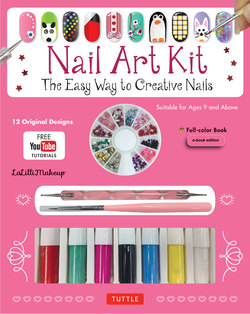Читать книгу Nail Art Ebook - LaLilliMakeup - Страница 7
На сайте Литреса книга снята с продажи.
ОглавлениеPart 1
THE BASICS
Nail structure and composition
First, let’s see what nails are made of and take a look at their structure.
A nail is composed almost entirely of keratin, with small quantities of vitamins, mineral salts, fat, water, and amino acids making up the balance. Fragile and dry nails often contain less water than average, while flexible and soft nails contain a higher percentage of water than average, close to 18%.
In terms of its structure, the nail can be subdivided into the nail matrix (the germinal layer), the nail plate (the actual nail), the nail walls, and the nail bed.
● The nail plate: is the largest part of the nail. It consists of layers of keratin.
● Nail root: is the bottom of our nails and is visible in the lunula (that little half-moon at the base of the nail).
● Body of the nail: is the central, pinkish part of the nail.
● Free edge: is the free, protruding part of the nail that is not bound to the nail bed as the nail plate continuously slides forward over the bed. In nail jargon, the curved line that marks this edge is called the “smile line.”
● The nail wall is the folded cuticle that covers the edges of the nail bed and the base of the nail (its root).
● Finally, the nail bed is a dermal tissue full of nerves and blood vessels.
COMMON PROBLEMS….and a few helpful tips
Nails can say a lot about your health. Polish can help conceal minor blemishes, but covering isn’t enough. Nail disorders should never be ignored. Healthy nails are strong, smooth, even, and of a uniform light-pink color.
● Brittle nails: weak and thin, brittle nails tend to break easily. Brittleness can be due to vitamin and/or mineral deficiency. As we’ve noted, keratin is the main component of nails, but the vitamins, minerals, fats and other elements that make up the smaller portion are important too. A deficiency in any of these can affect texture and thus weaken the nail. Frequent contact with solvents, detergents or other strong substances also causes deterioration, so wear rubber gloves when using them.
● Purple or purplish-blue nails: generally in cold weather nails, like lips, assume a purplish-blue hue, indicating poor blood circulation.
● Yellow nails: the regular use of dark or low-quality polishes can cause yellowing (so can smoking, so don’t do it!). Always apply a base coat before the colored one.
● White spots: white specks that sometimes appear on nails are nothing more than tiny air pockets caused by minor trauma.
● Black spots: theses are tiny hemorrhages, the kind that happen when a nail is crushed; if you’ve ever caught your finger in a door, you know what I’m talking about. These spots last a while, but eventually disappear.
● White nails: watch out for nail fungus!
● Ridged nails: these may indicate calcium deficiency.
Strong, healthy nails begin with a balanced diet. Magnesium, calcium, and vitamin D all facilitate growth, while vitamin B makes nails stronger. Don’t bite! Bitten nails are unsightly and biting leaves nails vulnerable to infection. Preparations and polishes that are designed to prevent biting can help.
My advice Prepare a solution of olive oil, onion, garlic or garlic oil, a drop each of vinegar and chili pepper, and spread it on your nails, blotting away any excess.
Your mouth — and vampires — will remain far from your hands!
QUICK SOLUTIONS
for the most common problems
Slow growth: polishes that accelerate growth are available on the market.
Brittle nails: stay away from nail polish for several days and moisturize your nails thoroughly. Apply hand cream or shea butter morning and night, and try rubbing in some castor, olive and/or argan oil.
Splitting nails: avoid frequent manicures and file with a coarse-grained emery board; use acetone-free removers; apply a strengthening base coat over nails that have been rubbed with shea butter.
